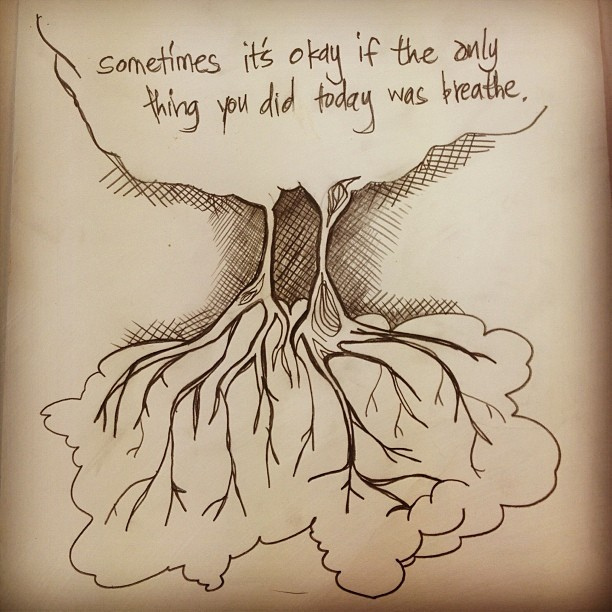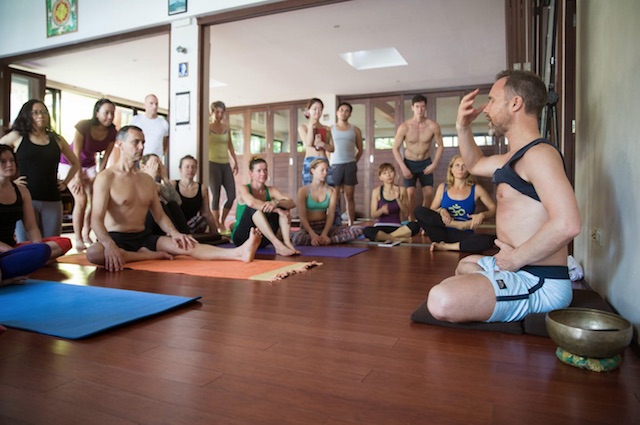
Hello. It’s me—the woman sitting off to the side near the back of class.
Yes, I’m a drop in, but I’ve taken this class before and I love it. It’s a respectable, challenging and laugh-out-loud time…except for the pranayama thrown around in it.
I know that probably sounds harsh. But at this point I have to say something, because it’s important, because everyone taking these classes and teaching these classes is important, and intelligent, and might benefit from some more information.
What I see now when I drop into classes like these are a lot of teachers trying, with good intentions, to incorporate techniques—like a breath of fire or a random breath holding—without a solid understanding about what these practices do to the body after the initial sensations wear off.
Pranayama has the potential to influence shifts and transformations in the nervous system when done correctly. Yet this path is not one of instant gratification; it is a subtle, penetrating and more deeply satisfying experience when done correctly over time. Compare this to a hectic pumping of the abdomen with no guidance or reason that, over months, has the potential to cause the system more harm than good.
I don’t know why I stumbled on a different path, but I am glad I did. And now I feel a responsibility to explain why I see it as detrimental to be throwing these practices around loosely, just for the temporary sensation of it, in mixed-level asana classes.
After five years developing a pranayama practice under the guidance of a dedicated and qualified teacher (Paul Dallaghan, who is certified to teach pranayama by Sri O.P. Tiwari, a master teacher in a lineage later described), I feel it’s time to explain this through the lens of five reasons that I don’t do just any old breathing exercise thrown my way.
I hope that through reading these reasons you might actually want to check out these practices and their potential benefits (I hope for this so much that I don’t mind if you skip my words and spend time directly with a master teacher by scrolling down to a videos at the bottom!):

1. Through asana practice, I learned that the best results came from detailed, grounded instruction, regular practice, dedicated effort and continuous reflection—pranayama is no different.
The pranayama practices I was drawn to and stuck with were so attractive because from my first interaction with my teacher, he was precise in correcting me and showing me, gradually, how to do them properly. Instead of blindly engaging in some breathing, I felt that I was doing something for a purpose and being guided according to a grounded set of reasons. Truth be told, it took a couple of years for me to actually get into a daily habit with these breaths—they demand a level of discipline. But even if I faltered, they always called me back, they never really let me go. I always heard them asking me to start again.
Today, I join students around the world who engage daily in practices that have been passed down carefully through teachers who, through years of focused practice, experienced shifts in their nervous, and overall psychosomatic systems. This is due to techniques that—very basically and repeatedly—draw energy and focus down the center of the body, rather than jack it up further where it’s already over-emphasized.
Repetitive breathing practices, like rounds of sun salutations, seem tedious at first, unless we have a solid sense of commitment and are doing them so that we can really dig deep and do them correctly, every time.
They involve developing an understanding of the difference between the lower and upper abdomen and a fine-tuning of the pelvic floor, as well as practice with locking the throat on retentions so that pressure doesn’t build in the head.
2. The nervous system is complicated and adaptable, so if we take it into our hands, we need to know what we’re doing.
Did you know that your autonomic nervous system (the part of your nervous system that is not within direct conscious control) has two functional branches? They are the sympathetic (fright or flight) and the parasympathetic (rest and digest). When one is dominant, the other “steps further into to the background.”
Take the extreme case of someone being chased by a bear. Their digestive system (parasympathetic activity) will shut down as the body concentrates all of its nervous energy on escape or an immediate, active reaction to the situation (sympathetic response).
While we are thankfully not often facing near-death experiences, we are in notably stressful states for prolonged lengths of time over any given day. You get a message from someone at work asking for something when you are at a movie on a first date; you’re running late and your phone is dying and you don’t have a map point to the location; you’re stuck in traffic before an interview—every day, there’s something. Actually, a lot of things. Some people are addicted to this level of stress. It’s become a popular nervous set point.
Yet, even if someone can sustain it, this set point is actually more of a guarded, survival state than a relaxed, open, compassionate state. Our parasympathetic functions are thus compromised. So practices to disengage the sympathetic and engage the parasympathetic impulse of the nervous system would behoove all of us.
Let’s look quick at a practice I see thrown into a lot of classes, called “breath of fire,” which is actually a vague description at best and a misnomer at worst. There is already a fire/heat in the body, constantly. (This is essentially what is celebrated with fire ceremonies and what is described as agni in ayurveda. It is our inner sun, our metabolic activity summing up the physical processes of the body.)
When approached with sincerity and care, pranayama techniques can actually serve to channel it for a deliberate reason—to cause remarkable and favorable shifts in the system. When approached haphazardly, this fire spreads—like when wind blows on a forest fire causing more and more damage with every gust. So in either case, we are working with this fire. But what I’m asking is why do we want to do this? Is it that “high” feeling? Does it look good to join in and “know what they mean” when the teacher calls it out?
Before your next practice, it’s worth considering the answer to this question.
3. The Hatha Yoga Pradipika explains that as much good can be done through pranayama practice as damage, depending on how you approach it. This also implies the guidance of a qualified teacher.
Our nervous system is an incredibly dynamic gift. We can go our whole lives without consciously doing anything about how it functions. But if we do decide to practice techniques that affect it, it’s wise to approach them with respect and care for the outcome. A qualified teacher can see clearly where we are with our practice through reading the pulse and observing our technique.
If we approach pranayama with an ego-led mindset of competition, we are bound to hurt ourselves. For example, it won’t benefit us to focus on the length of our breath so much as focusing all of our attention on how we are breathing, and how we engage all parts of our body and attention while doing it, over and over again. Breath work is not about instant results, or obvious ones, at first. It is subtle work by its nature. The rewards are gradual and personal.
When practiced sincerely, every day, for years, these practices can have a powerful cumulative effect. Fundamentally, they can gradually improve your ability to handle stress on all levels.
4. These practices have been studied, over the years, by a solid lineage of experienced practitioners who measure progress through the individual practitioner’s pulse.
According to Swami Kuvalayananda, teacher of Sri O.P. Tiwari and Paul Dallaghan:
“If understood through the modern scientific approach, yoga would help greatly in the spiritual and material renaissance of the human society.”
This is the heart of any point I would like to make. Swami Kuvalayananda saw that it was important to ground these practices from their mystical and purely belief states with reflective and repeatable scientific research. His vision is remarkable, and has been carried through by Sri O.P. Tiwari who oversees Kaivalyadhama Institute, in Lonavla, near Pune, India, and by Paul, who leads retreats and training courses at Samahita Retreat, in addition to his PhD research work studying the scientific and ethnographic effects of yoga practices at Emory University in the United States.
During a pranayama advanced education course, my pulse is taken about four times, and then Paul administers a prescription for my breath work based on my pulse, what he has observed of my practice and any stated concerns—all related to my system and its relative state of balance or imbalance.
5. This life is a gift, especially when you treat it like one.
It doesn’t come with an instruction manual. It never has, for anyone. But many would agree that inner work is reflected in outer experiences. I have learned that my nervous system and my ability to adapt to stress and engage with people in an increasingly compassionate and calm way are priorities to me. Thus, rather than focusing first on an excessive lists of achievements, I see that an inner state of connection and balance is fundamental to everything else I am doing in my life—it is the grounds for everything else. My ability to cultivate this ripples out to every other aspect of my existence and everyone else related to me.
So yes, I enjoy practicing with everyone in this studio. Yet, I’m the one sitting in class waiting patiently for the breath of fire to pass over the room. I don’t have bad feelings. I just choose my state of balance over fitting in. And I don’t think it’s fair to keep this my little secret anymore, especially since I’ve come to experience the benefits more and more. Benefits that you just have to apply yourself sincerely to experience for yourself, because they are personal, yet very tangible.
As promised, here’s that collection of introductory pranayama videos by Paul!
Author: Emily Alp
Image: Buttermilk./Flickr; Author’s Own
Editor: Emily Bartran











Read 1 comment and reply